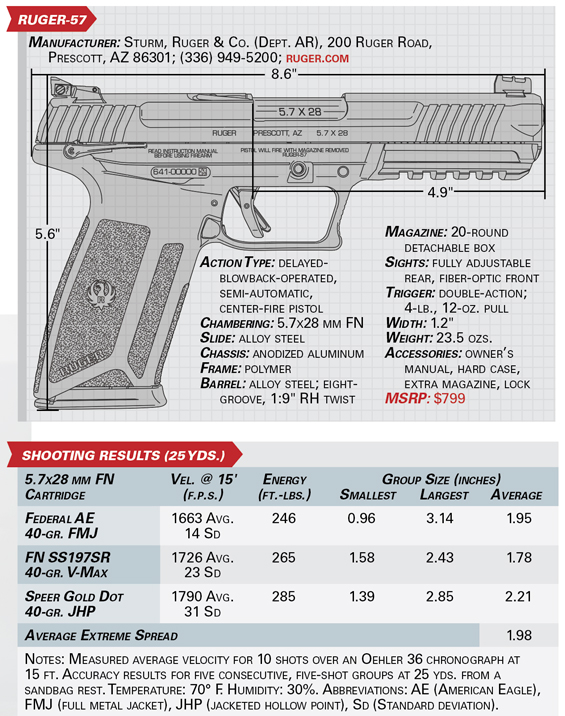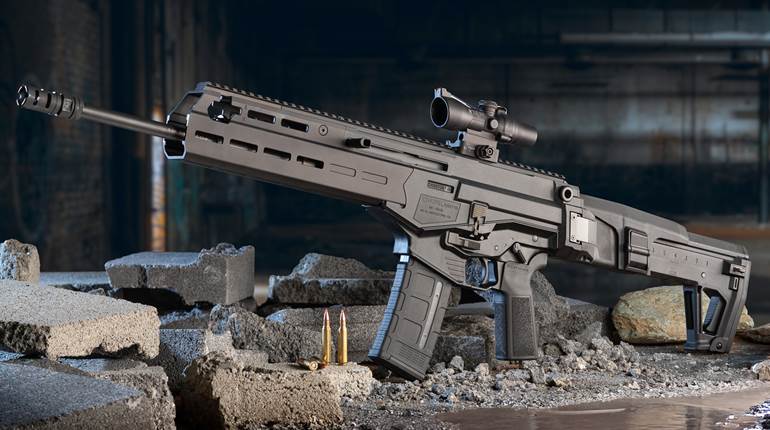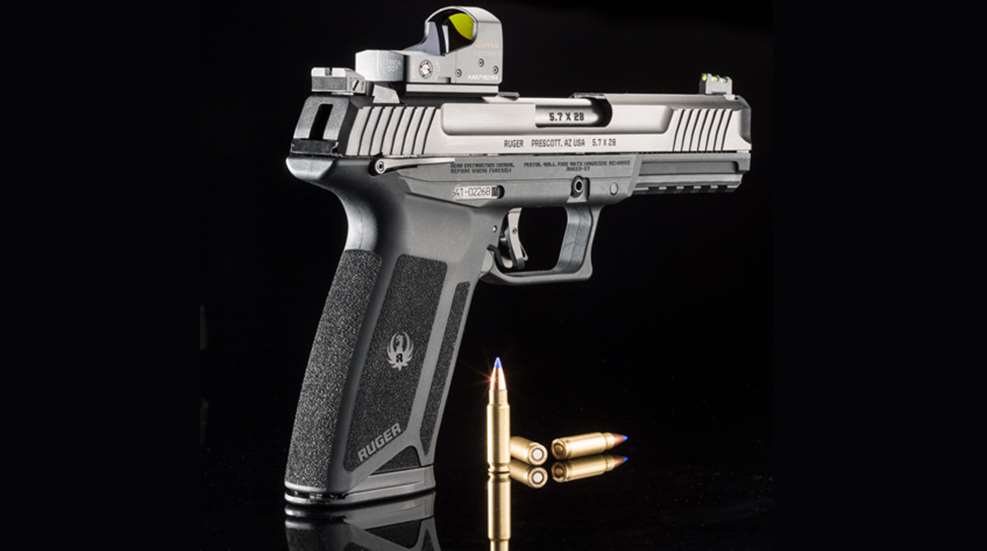
With precious few guns on the market chambered to fire it, and even fewer load options for those guns, the 5.7x28 mm FN cartridge has seemingly been on life support for most of its 30-year lifespan, kept alive only through the patronage of a small but dedicated fan club and select military/government agency adoption. That’s a shame, because it’s an interesting little chambering, offering several intrinsic design advantages, and it is an absolute hoot to shoot. Caught in a self-perpetuating loop where a deficit of firearm options has led ammunition makers to deem it unworthy of their finite production resources—and vice versa—what the 5.7 mm has really needed to help resuscitate it was a major gunmaker willing to break the vicious circle by taking a chance on it. That it was Ruger to step up to the plate, with its December introduction of the Ruger-57 handgun, should not come as any great shock to those familiar with the Southport, Conn., company’s reputation for seeing opportunity where others just see risk.
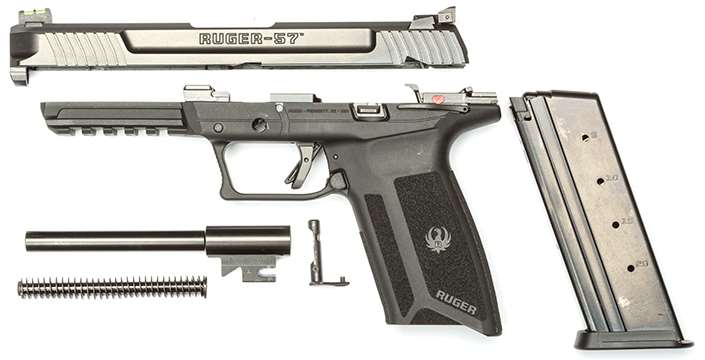
I have long said that if a major manufacturer were to introduce a 5.7x28 mm FN-chambered handgun, featuring conventional controls and sold at a reasonable price, it would sell like hotcakes—but the stipulations to my prediction are vital to its fulfillment. Fabrique Nationale’s Five-seveN has never caught fire with American shooters despite decades on the shelves, due to its curious polymer-over-polymer appearance, its unorthodox forward-mounted safety and its $1,400 price tag. In designing its new pistol, Ruger appears to have taken these perceived shortcomings into account, as the company has developed a 5.7 mm handgun the same general size and weight as the Five-seveN, employing a similar operating system, yet one that is much better suited to American sensibilities, with M1911-style thumb safeties and an MSRP of only $799.
On paper, the 5.7x28 mm FN cartridge is something of an oddball choice for a handgun chambering. Introduced by FN in the early 1990s, it’s essentially a miniaturized 5.56x45 mm NATO rifle round, utilizing a 0.224" rifle projectile and operating at rifle-caliber pressures to achieve blisteringly fast velocities—not really the handgun way of doing things. But on the range, it’s a match made in heaven.
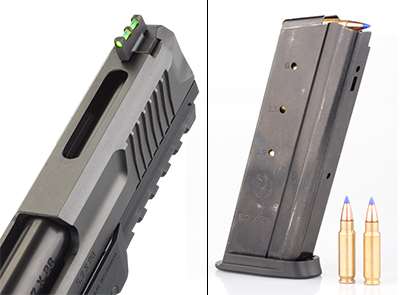
All that speed translates to uncommonly flat trajectories for a pistol, and the lightweight projectiles yield negligible perceived recoil while still producing kinetic energy levels not far below those of 9 mm Luger loads. Meanwhile, the 5.7 mm’s case measures a scant 0.31" in diameter at its widest point, allowing for standard capacities, using flush-fitting detachable box magazines, higher than what is possible with the 9 mm or other, fatter, handgun cartridges—while still keeping the width of the grip frame thin enough to accommodate nearly all hands.
The Ruger-57 is a large but light polymer-frame pistol, measuring 8.6" long with a 4.9" barrel, but weighing only 23.5 ozs. empty. Standing 5.6" tall, the gun feeds from a steel detachable box magazine with room onboard for 20 rounds, yet the 5.7 mm ammunition has such little weight to it that a full complement of rounds only takes the handgun’s heft up to 28.4 ozs. This is a remarkably feathery total for a fullsize pistol loaded to capacity. Ruger is making a concerted effort to create a consistent brand image for its pistols, which is why the new 5.7 mm bears more than passing resemblance to the company’s Security-9, which itself takes many of its visual cues from the LCP II. The Ruger-57 also shares a few internal similarities with the Security-9, and we will get to those shortly.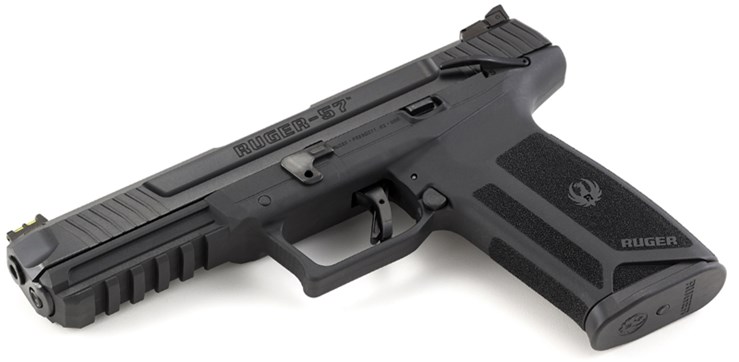
One marked difference, however, is the action. Unlike the Security-9—a locked-breech, recoil-operated gun—the new pistol makes use of a delayed-blowback system in which the barrel and the slide are held together only by recoil spring tension while in battery. However, unlike a traditional blowback-operated handgun, the Ruger-57’s barrel is not fixed in place, and, following ignition, the slide and barrel move straight back together when acted upon by the blowback of the cartridge case. The barrel travels rearward only about 1/4" before a U-shaped recess in the rear of the barrel lug makes contact with a transverse pin in the frame, arresting its movement, but the slide and barrel are held together long enough for the projectile to leave the muzzle and for pressures to drop sufficiently that they can safely separate. Once the slide has finished its cycle, and is returning forward under the tension of the recoil spring, the barrel joins it to re-establish battery.
Like the Security-9, the pistol employs both Ruger’s Secure Action Trigger, a partially pre-cocked double-action design, and a hammer-fired ignition system. The trigger is set within a CNC-machined aluminum fire-control chassis that is secured to the frame via a pin forward of the takedown lever. The rearward motion of the reciprocating slide does most of the work of cocking the internal hammer, but pulling the trigger completes the task before releasing it to impact the cartridge’s primer. In addition to the manual thumb safeties, the Ruger-57’s trigger also features a blade-in-trigger safety to further protect against unintentional discharge.
My test sample’s trigger break was light but with a modest amount of creep and a long reset that required it be returned most of the way forward before it re-engaged. Reset was quite positive, however, with a distinct audible and tactile click. A Lyman Digital Trigger Gauge was used to measure the break for 10 trigger pulls, and the average came to 4 lbs., 12 ozs.
The Ruger-57’s slide is made of alloy steel to which a black-oxide finish has been applied. Located both fore and aft, the pistol’s broad cocking serrations are not only angled forward, but the curve of the angle sharpens slightly about half way up the slide. Also constructed from alloy steel, the pistol’s barrel has undergone a salt-bath-nitride casehardening treatment to help ensure longevity, keeping the relatively high pressures of the 5.7 mm cartridge from burning out its eight-groove, 1:9" rifling.
To ensure proper functioning of the 5.7x28 mm FN cartridge with the delayed-blowback action, Ruger engineers had to remove quite a bit of weight from the slide, and they did so through a 1½"x1/3" lightening cut along its top surface, deeply beveled recesses at the pistol’s nose and by trimming as much excess metal from the sides of the slide as was possible. To the same end, the Ruger-57 employs a relatively stiff recoil spring, resulting in a moderately hard-to-rack slide. With the slide locked back, the forward tension was great enough on my test gun that I could not close the action by depressing the lock lever—it had to be slingshot using the support hand.
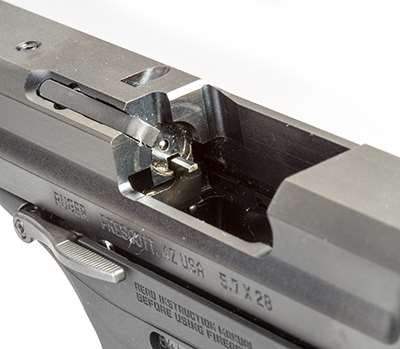
An external extractor is curiously positioned at about 1 o’clock on top of the slide at the rear of the ejection port, as is a loaded-chamber viewport that permits just a smidgen of the cartridge head to be seen when a round is chambered. The reason for the extractor’s unconventional orientation—and for the corresponding placement of the ejector at the 6-o’clock position on the bolt face—is simply because there isn’t real estate available to put it anywhere else. The diameter of the 5.7x28 mm FN’s case head is so small (and mostly occupied by the primer pocket), and the breech space is so limited (a problem exacerbated by the aforementioned removal of metal), that a traditional side-by-side arrangement just wouldn’t fit. Initially, I was concerned about the impact this could potentially have on the trajectory of spent cases, but throughout the entirety of my testing I was not struck by a single empty.
Sights on the pistol consist of a fully adjustable blade rear, which has been serrated on its aft face to cut down on glare, and a green fiber-optic pipe front for rapid sight acquisition. Both elements are dovetailed into the slide—the front using the popular Novak front pattern and the rear using the same cut as is used by Ruger’s American pistol. Although it might not be apparent at first glance, the Ruger-57’s slide is also drilled and tapped from the factory for the attachment of optic-mounting plates that permit shooters to install micro reflex-style sights atop the pistol.
The company is making four different mounts that should cover the great majority of the various red-dot options on the market. No plates ship with the gun, but they will be available aftermarket at shopruger.com for $40 each. Also to consider, the Ruger-57’s factory sights are not of sufficient height for both to be seen through the window of an optic, making co-witness impossible. So, until you find some suppressor-height aftermarket sights to swap in (and I’m not certain that an option using the Ruger American rear dovetail even exists), it’s a one-or-the-other scenario.
Ruger molds the pistol’s frame from glass-fiber nylon, a rigid polymer that flexes very little when stressed, despite its light weight. A five-slot accessory rail is integrated into the dustcover, and given that I can’t think of a single light or laser that requires that much real estate, the inclusion of so many slots is likely another weight-reduction measure. In recent years many manufacturers have chosen to err on the side of coarseness when designing the texturing on their polymer-frame pistols, and I’m glad Ruger avoided that impulse with this gun, as the docile 5.7 mm doesn’t require it. Instead, panels of fine stippling are used that, while granular enough to provide purchase during recoil, aren’t sharp enough to eat into the shooter’s hand in an unpleasant way.
In an orientation that will already be familiar for shooters of modern M1911s, Browning High Powers and many other platforms, bilateral two-position thumb safeties are present at the rear of the frame (up is safe and down is fire), and the safeties click very distinctly between the two settings. With the safety on, the left-side paddle extends inward to engage a notch in the slide, physically blocking its movement. The reversible magazine release button is found just behind the trigger where it can be depressed by the thumb of the shooting hand, however, a slide stop is only present on the left side of the frame for right-handed use.
Measuring 2.1" in length by 1.1" in width, the grip is relatively long from front to back, but it’s thinner from side to side than most contemporary double-stack 9 mms. In my experience, only people with the tiniest of hands and the shortest of fingers will struggle with this arrangement. However, as the Ruger-57 has no provision for adjusting the circumference of the backstrap, what you see is what you get. Indentations cut into the magazine well allow the magazine’s baseplate to be securely grasped for forcible removal in case of a malfunction.
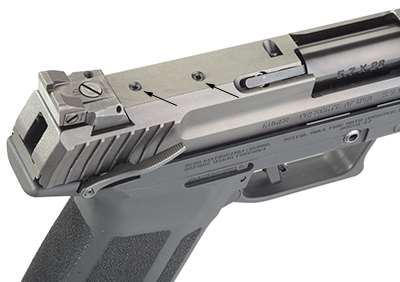
Two steel magazines (similar to, but not interchangeable with, the Five-seveN’s polymer box) ship with the gun, and they are designed with a feature that your thumbs will appreciate. Unlike most double-stack handguns, the Ruger-57 utilizes a double-feed magazine that loads more like an AR magazine than a pistol magazine. As a result, I’ve found that I can top-off Ruger-57 magazines just as quickly without the assistance of a speedloader as I can a 9 mm with my trusty Maglula.
The gun comes in a rather nice hard case, and, if stored with a chamber flag in place, it will accommodate the presence of most slide-mounted optics. Fieldstripping the pistol does not require that the trigger be pulled, and while the process does deviate slightly from the norm for modern handguns, it’s a straightforward enough procedure that I don’t feel the need to detail it here.
As previously noted, 5.7 mm ammunition options are extremely limited—with a few FN-branded loads and Federal’s American Eagle FMJs making up pretty much the entire market—but there appears to be a bit of movement on that front as well. Speer has just expanded its Gold Dot personal defense line with a new 40-gr. 5.7x28 mm FN offering. Like the rest of the Gold Dot line, the new load features bonded-core construction and nose cavities tuned for both optimal penetration and expansion. For the purposes of testing out the new Ruger-57, I was able to corral not only large supplies of FN’s SS197SR cartridge (loaded by Fiocchi and topped with a 40-gr. Hornady V-Max bullet) and Federal’s American Eagles, but also a few pre-production boxes of the new Gold Dots.
Function testing was conducted both with and without a slide-mounted red-dot installed, in this case a Burris FastFire 3, to ensure reliability in both circumstances. Fortunately, it ran without any stoppages in both scenarios, to the tune of about 600 rounds, with the extra 1.2 ozs. added by the optic and its mount not having a detrimental impact on the functionality of the delayed-blowback system—although I assume there is a threshold over which the weight of an optic will begin to cause reliability issues. The Ruger-57 does not employ a magazine disconnect safety, and will thus fire with its magazine removed.
Accuracy testing was exclusively done with help from the optic and its 3-m.o.a. reticle. From the factory, shooting the more prevalent 40-gr. ammunition, the gun’s sights appeared to be regulated for use at 10 yds., however, 27-gr. options do exist, and the adjustable rear sight will allow shooters to dial-in their point of impact to match their ammunition choice. Rifleman’s accuracy protocol for testing fullsize pistols is five consecutive, five-shot groups at 25 yds., and the Ruger/Burris combo produced some fantastic groups at that range.
FN’s sporting round was the most consistent load tested, shooting a 1.78" five-group average, four of the five groups measuring between 1.58" and 1.65". The practice American Eagles produced both the largest (3.14") and smallest (0.96") groups of the day, for an average of 1.95". Speer’s new Gold Dot self-defense load also acquitted itself well, managing a 2.21" average. The 15-group average extreme spread for the three ammunitions through the pistol came to 1.98", a fine result for a handgun at 25 yds.
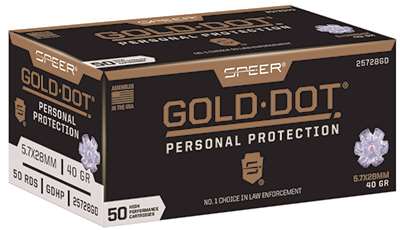
During one of my range sessions with the new Ruger, I also took along a Walther P22 and Heckler & Koch VP9 for comparison. Although hardly scientific, I’d estimate that recoil of the 5.7 mm through the Ruger-57 felt roughly half that of the 9 mm Luger through the VP9, much more nearly approximating the experience of shooting the .22 rimfire than the 9 mm. However, this little flamethrower is a blast to shoot—literally—and those shooters particularly sensitive to blast may get the impression that the pistol is recoiling more than it really is.
So, as a fullsize 5.7x28 mm FN-chambered pistol, what is the Ruger-57 really good for? Some may question the cartridge’s self-defense chops, but I, for one, do not—and it seems that Speer doesn’t either. The energies produced by the handgun are on the borderline of what’s considered adequate for martial use, but its generous magazine capacity, controllability (greatly hastening follow-up shots) and red-dot compatibility more than make up for this in my opinion.
Accessorized with an optic and a light, the Ruger-57 would make a great, unintimidating home-defense pistol for those who, for whatever reason, don’t want the kick of the 9 mm Luger. Concealed carry may be an issue for some from a size perspective, but it’s not a problem from a weight standpoint; a fully loaded Ruger-57 weighs almost 2 ozs. less than a similarly filled Glock 19—quite possibly the most carried handgun in the world. Also, while limited, there are potentially a few short-range varmint-hunting applications for this gun. And, of course—between the pleasure of shooting it and the cool factor of the cartridge—the Ruger-57 is a range queen par excellence.
It’s difficult to forecast just how much of an impact the Ruger-57 will have on the 5.7x28 mm FN market. I have no doubts it will sell, as the gun ticks all the right boxes—it’s reliable, accurate, full-featured, wisely configured and with a price literally half of its most direct competitor. But will it be enough to revive the ailing cartridge? Will demand prompt the ammunition makers to sit up and take note? Speer is already onboard with its new Gold Dot load, but will others follow suit?
Ruger’s modern reputation as a bellwether for the rest of the industry is well-deserved, so I think there’s an excellent chance that they will, and I hope they do, as the little cartridge deserves more of a chance than it’s been given thus far. But who can know? The most definitive I can be at this point is to say that now is an interesting time for the 5.7x28 mm FN cartridge—and it’s been a long while since that could be said.